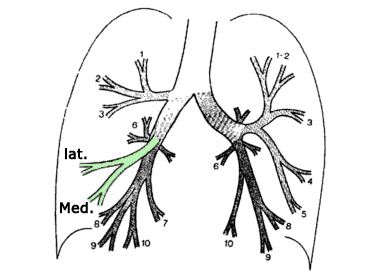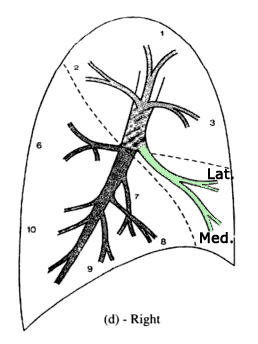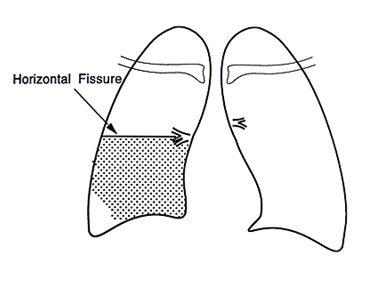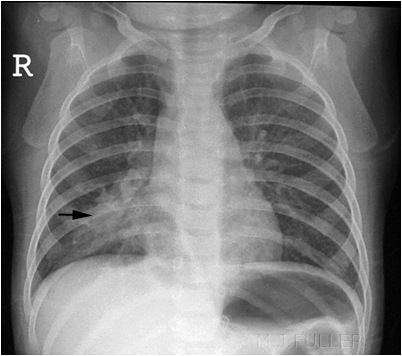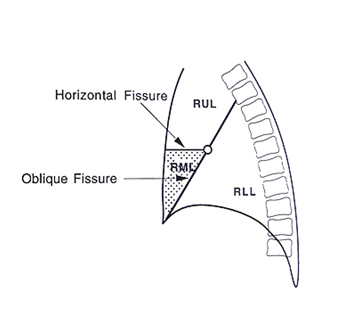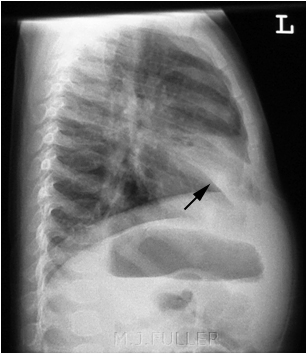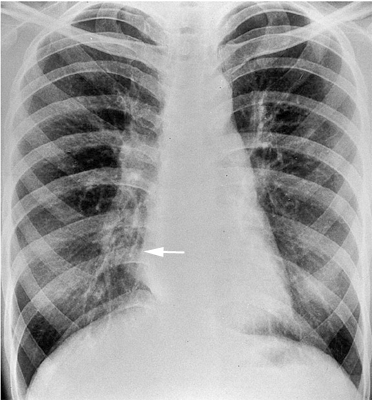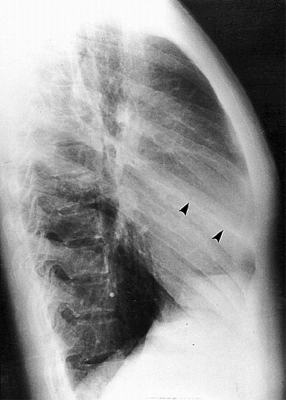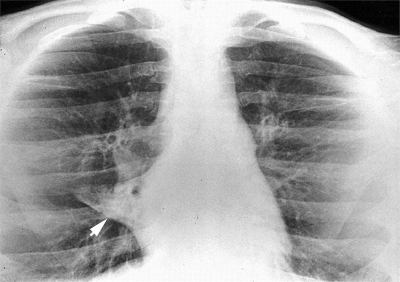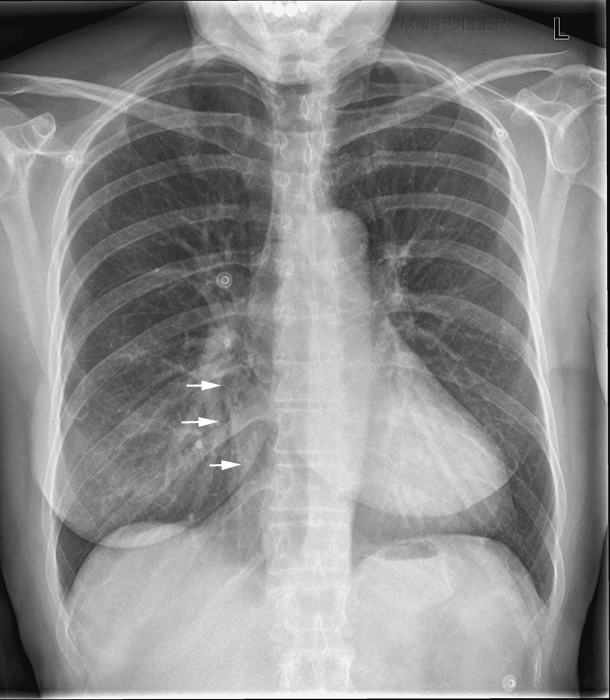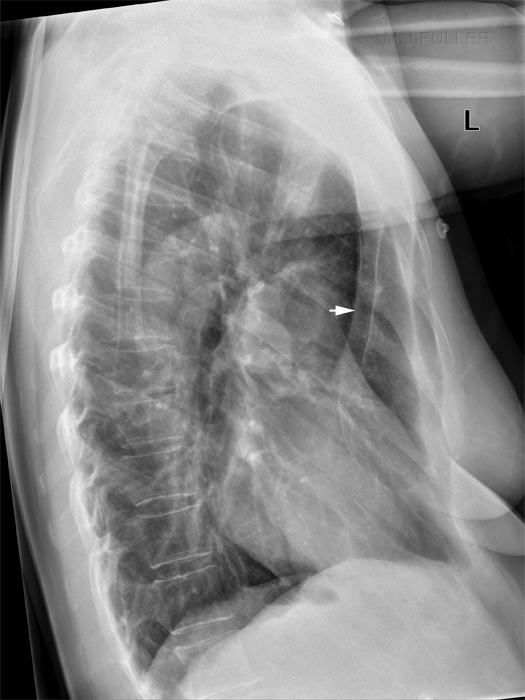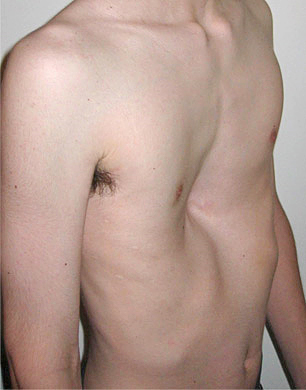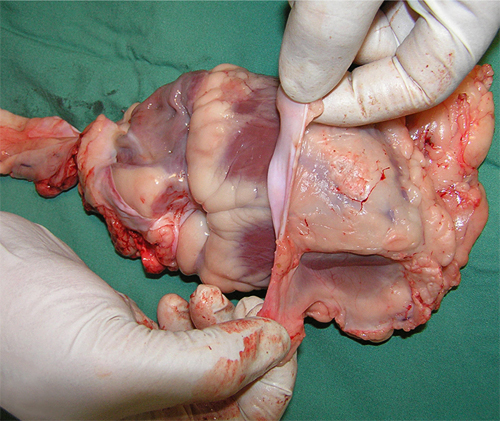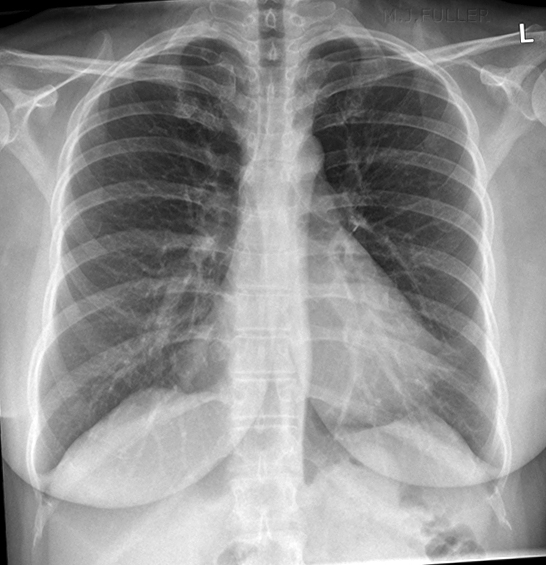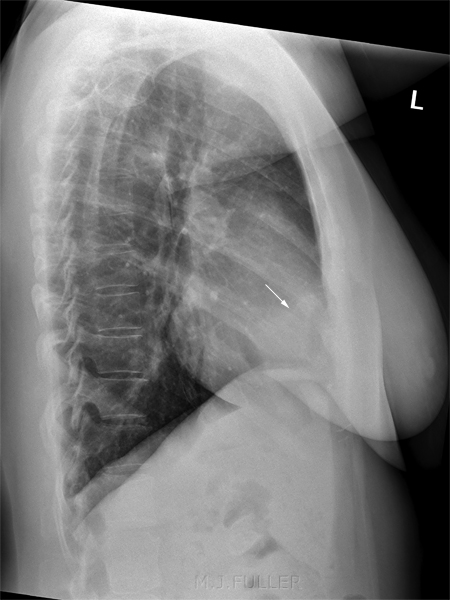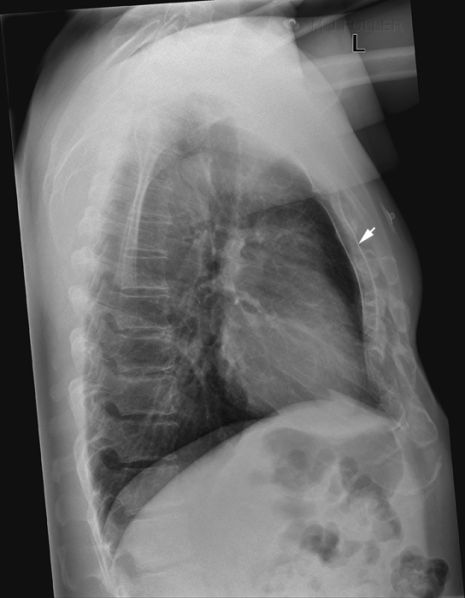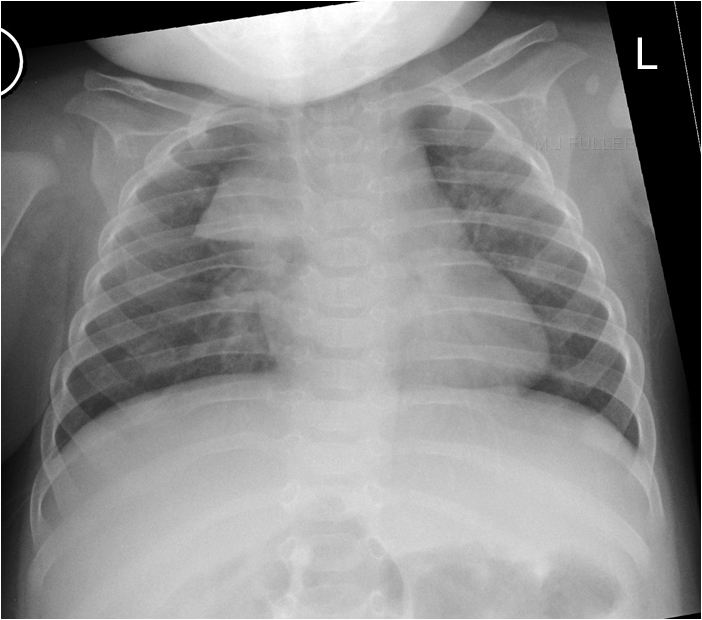Right Middle Lobe Consolidation
Right Middle lobe (RML) is a relatively common site for consolidation. Its wedge-shape must be understood in three dimensions to fully understand its appearance on plain film
The Meaning of the Term Consolidation
One of the unfortunate aspects of the term consolidation is that its meaning can be different depending on who is using the term. When a clinician uses the term consolidation he/she is usually referring to a consolidation associated with acute pneumonia. Thus, the term consolidation and pneumonia have very similar meanings and are almost used interchangeably.
Strictly speaking, the term consolidation does not imply any particular aetiology or pathology. Acute pneumonia is the commonest cause but not the only cause of consolidation. (other causes include chronic pneumonia, pulmonary oedema and neoplasm). Thus when a radiologist has reported a chest X-ray examination and notes the presence of consolidation he/she is simply stating that some of the long airspace has been replaced by a fluid.
Notes on Consolidation
- Refers to fluid in the airspaces of the lung
- Consolidation may be complete or incomplete
- The distribution of the consolidation can vary widely. A consolidation could be described as “patchy”, “homogenous”, or generalised”.
- A consolidation may be described as focal or by the lobe or segment of lobe affected
The Right Middle Lobe Anatomy
adapted from <a class="external" href="http://books.google.com.au/books?id=Bif0zpmEWtAC" rel="nofollow" target="_blank">By Fred W. Wright Radiology of the Chest and Related Conditions: Together with an Extensive Illustrative Collection of Radiographs CRC Press, 2002</a>The right middle lobe has two pulmonary segments which are situated side by side; the more lateral segment, approximates the size of its adjacent neighbour ( medial segment). The medial segment abuts the right heart border medially , while lateral segment extends to and comprises a portion of the lateral border of the right lung. <a class="external" href="http://lib.cpums.edu.cn/jiepou/tupu/atlas/www.vh.org/adult/provider/radiology/LungAnatomy/RightLung/RtLungSegAnat.html" rel="nofollow" target="_blank">http://lib.cpums.edu.cn/jiepou/tupu/atlas/www.vh.org/adult/provider/radiology/LungAnatomy/RightLung/RtLungSegAnat.html</a>.
When viewing chest radiographs with pathology involving the right middle lobe, it is important to think about the shape and position of the RML in three dimensions. This may not be easy at first.
adapted from <a class="external" href="http://books.google.com.au/books?id=Bif0zpmEWtAC" rel="nofollow" target="_blank">By Fred W. Wright Radiology of the Chest and Related Conditions: Together with an Extensive Illustrative Collection of Radiographs CRC Press, 2002</a>Further information on lung anatomy here
Plain Film Appearances of Lung Consolidation
Radiological appearances common to all lobes are:
1.Abnormal lung opacity2.Increase in the size and number of lung markings3.Loss of clarity of the diaphragm on the AP and/or lateral views4.Loss of clarity of the heart border on the AP and/or lateral views5.Air bronchogram lines6.Loss of the normal darkening inferiorly of the thoracic vertebral bodies on the lateral view7.Opacification of the lung behind the heart shadow or below the diaphragms
Loss of Visualisation of the Right Hemidiaphragm
Loss of Visualisation of the Right Heart BorderIt is widely considered axiomatic that the loss of visualisation the right hemidiaphtragm is a sign of RLL disease. Felson (<a class="external" href="http://www.amazon.com/Chest-Roentgenology-Benjamin-Felson/dp/0721635911/ref=sr_1_2?ie=UTF8&s=books&qid=1252240078&sr=1-2" rel="nofollow" target="_blank">Chest Roentgenology, W.B. Saunders, 1973, p38</a>) has challenged this contention on the grounds that the right hemidiaphragm is widely variable in its shape and could be obliterated by middle lobe disease in some patients
It is also widely considered axiomatic that the loss of visualisation of the right heart border is a sign of RML disease. Felson (<a class="external" href="http://www.amazon.com/Chest-Roentgenology-Benjamin-Felson/dp/0721635911/ref=sr_1_2?ie=UTF8&s=books&qid=1252240078&sr=1-2" rel="nofollow" target="_blank">Chest Roentgenology, W.B. Saunders, 1973, p38</a>) notes that in about 5% of normal individuals, the right border of the heart and aorta do not project into the right hemithorax. The silhouette sign cannot be applied to these individuals in respect of any loss of visualisation of the right heart border. It is also true that is some individuals with RML disease, silhouette sign will provide the only plain film evidence.
Lordotic Positioning for Right Middle Lobe and Lingula
<a class="external" href="http://bjr.birjournals.org/cgi/content/full/74/877/89#F6" rel="nofollow" target="_blank">
<a class="external" href="http://bjr.birjournals.org/cgi/content/full/74/877/89#F6" rel="nofollow" target="_blank"> K Ashizawa, MD, K Hayashi, MD, N Aso, MD and K Minami, MD
</a>
</a><a class="external" href="http://bjr.birjournals.org/cgi/content/full/74/877/89#F6" rel="nofollow" target="_blank">Lobar atelectasis: diagnostic pitfalls on chest radiography </a>
<a class="external" href="http://bjr.birjournals.org/cgi/content/full/74/877/89#F6" rel="nofollow" target="_blank">British Journal of Radiology 74 (2001),89-97 © 2001</a>The right cardiac border is not clearly seen suggesting silhouette sign associated with collapse and/or consolidation (white arrow). The appearance is a little inconclusive- the same appearance can be seen in patients with pectus excavatus
<a class="external" href="http://bjr.birjournals.org/cgi/content/full/74/877/89#F6" rel="nofollow" target="_blank"> K Ashizawa, MD, K Hayashi, MD, N Aso, MD and K Minami, MD
</a><a class="external" href="http://bjr.birjournals.org/cgi/content/full/74/877/89#F6" rel="nofollow" target="_blank">Lobar atelectasis: diagnostic pitfalls on chest radiography </a>
<a class="external" href="http://bjr.birjournals.org/cgi/content/full/74/877/89#F6" rel="nofollow" target="_blank">British Journal of Radiology 74 (2001),89-97 © 2001</a>the lateral image demonstrates a prominent oblique fissure (arrowed)
<a class="external" href="http://bjr.birjournals.org/cgi/content/full/74/877/89#F6" rel="nofollow" target="_blank"> K Ashizawa, MD, K Hayashi, MD, N Aso, MD and K Minami, MD
</a><a class="external" href="http://bjr.birjournals.org/cgi/content/full/74/877/89#F6" rel="nofollow" target="_blank">Lobar atelectasis: diagnostic pitfalls on chest radiography </a>
<a class="external" href="http://bjr.birjournals.org/cgi/content/full/74/877/89#F6" rel="nofollow" target="_blank">British Journal of Radiology 74 (2001),89-97 © 2001</a>The lordotic view image clearly demonstrates complete collapse of the right middle lobe (arrowed)
False RML Collapse/Consolidation in Patients with Pectus Excavatum
This patient presented for chest radiography with a history of recent facial nerve palsy. There is loss of the right cardiac border. There is no abnormal RML opacity. There is evidence of pectus excavatum (depression of the sternum). Pectus excavatum is a known cause of false RML disease and is likely to be a contributing cause of the pseudo-silhouette sign on the PA image. In these patients the heart tends to be displaced towards the left as a result of the limited space between the depressed sternum and the spine.Other contributing factors could be pericardial fat (although none is seen in this patient) and overlying pulmonary vessel. Pectus Excavatum
<a class="external" href="http://en.wikipedia.org/wiki/File:Pectus1.jpg" rel="nofollow" target="_blank">http://en.wikipedia.org/wiki/File:Pectus1.jpg</a>
False RML Collapse/Consolidation in Patients with Pericardial fat
Pericardial Fat
<a class="external" href="http://jcmr-online.com/content/11/1/15" rel="nofollow" target="_blank">Validation of cardiovascular magnetic resonance assessment of pericardial adipose tissue volume</a><a class="external" href="http://jcmr-online.com/content/11/1/15" rel="nofollow" target="_blank">Adam J Nelson , Matthew I Worthley , Peter J Psaltis , Angelo Carbone , Benjamin K Dundon , Rae F Duncan , Cynthia Piantadosi , Dennis H Lau , Prashanthan Sanders , Gary A Wittert and Stephen G Worthley</a><a class="external" href="http://jcmr-online.com/content/11/1/15" rel="nofollow" target="_blank">Cardiovascular Research Centre, Royal Adelaide Hospital & Disciplines of Medicine and Physiology, University of Adelaide, Adelaide, SA, Australia</a>This is a sheep's heart with the pericardium partly dissected off. Note the pericardial fat.
Felson (<a class="external" href="http://www.amazon.com/Chest-Roentgenology-Benjamin-Felson/dp/0721635911/ref=sr_1_2?ie=UTF8&s=books&qid=1252240078&sr=1-2" rel="nofollow" target="_blank">Chest Roentgenology, W.B. Saunders, 1973, p55</a>) notes that "For reasons that escape me, fat in the thorax is often impossible to differentiate from water density. Perhaps the adjacent pulmonary gas density has something to do with this illusion." This is an interesting point given the clear differentiaton between fat and water density structures seenin the abdominal plain film.
Case 1
The Paediatric Thymus
Applied Radiography - by M.J.Fuller
The triangular density demonstrated in the right upper thorax is not RML disease. Rather, it is a normal paediatric thymus.
... back to the Applied Radiography home page
